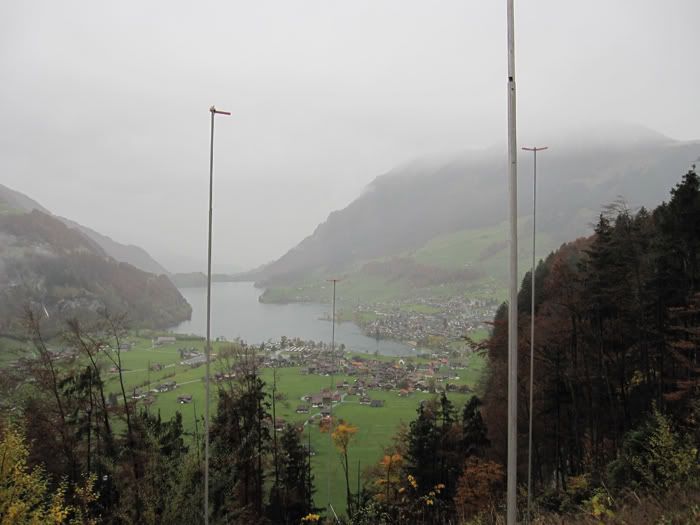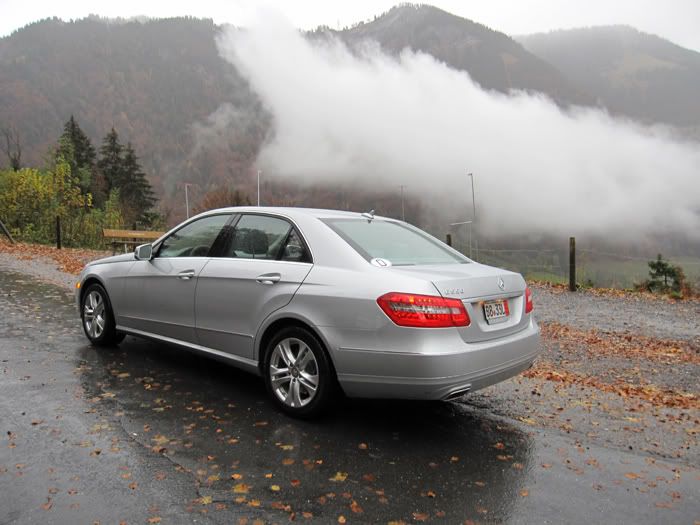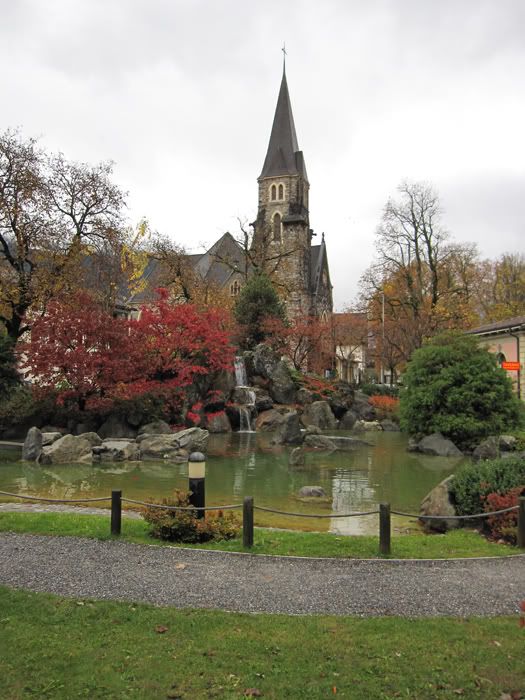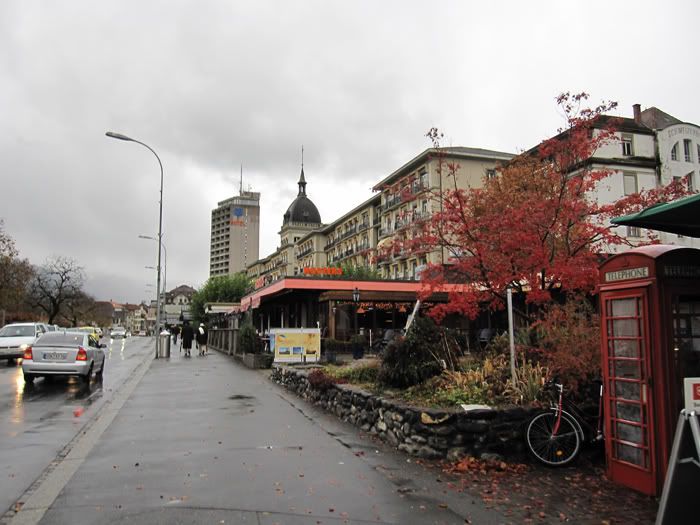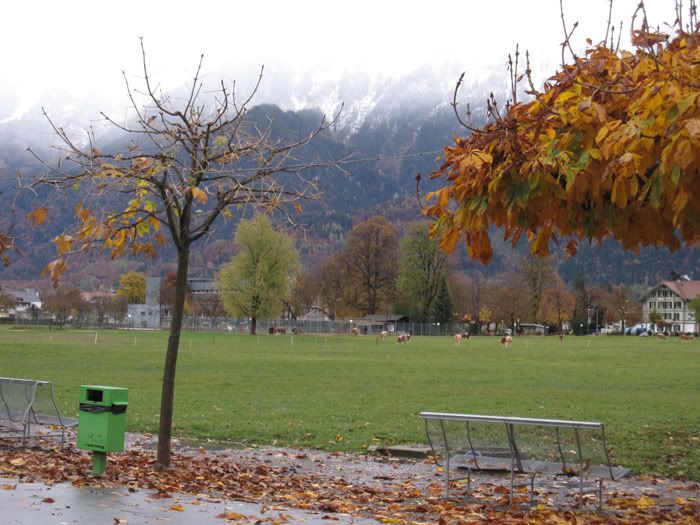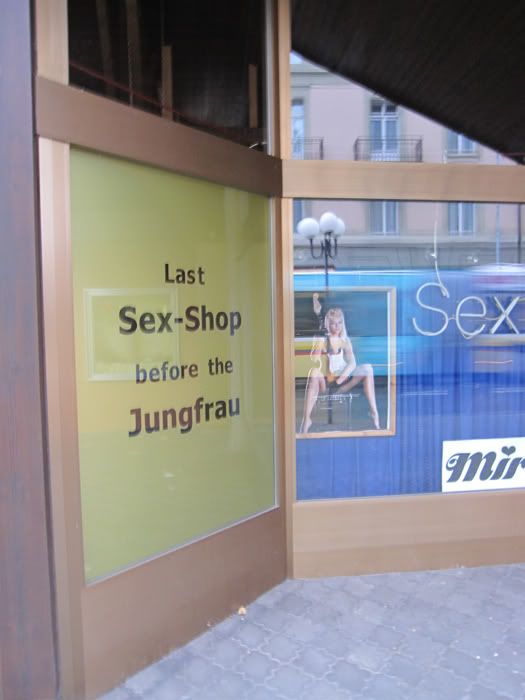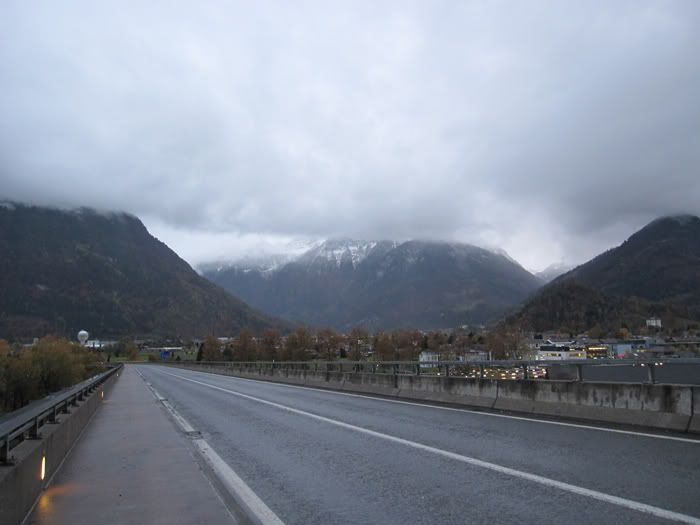The journey continues on November 2nd, 2009, as I push my way out of Italy and into Switzerland.
I woke up to a very cloudy, drizzly morning in the Como area, and after eating the ample breakfast buffet at Hotel Cruise, checked out and continued driving. I do want to say that Hotel Cruise was one of the most modern places I had ever stayed in, although it had all the character of a business/convention hotel rather than one that leaves an impression in the minds of tourists. Nevertheless, if I ever find myself driving around Como again, I will stay there again.
Although re-entering Autostrada 9 would have led immediately to Swiss Autobahn 2, I decided not to do that; instead, I decided to take a leisurely drive along the west shore of the Como. Although I honestly wanted to get to the village of Bellagio (the namesake of Las Vegas's posh Hotel Bellagio, which comes with its own Lake Como) in the dead middle of the lake, my study of the Microsoft AutoRoute map hinted that its streets seemed impossible to negotiate, so I decided to settle for Menaggio halfway up the west shore, from where I could drive on to the Swiss city of Lugano and join Autobahn 2 there.
I fueled up at a Shell station at the edge of Como, but had no luck buying a Swiss toll sticker. I decided to continue on, following a road that was signed as SS340; despite the numbered route status, the road was ridiculously narrow, and I was forced to share the road with big vans and other awkward vehicles, on a road that was too often barely 1 lane wide. My progress was painfully slow, and although the cliffs and the villas looked as fabulous as they had on the Rick Steves videos, I had zero view of the lake nor the mountains around thanks to the fog. Moreover, my mother was really getting on my nerves; due to the narrow road, she was convinced that I was going to scratch her brand-new luxury car right here, and every moment she shouted and whined, I was being distracted, and stepping ever closer to actually getting the car scratched. I was relieved to reach Menaggio, where SS340 took a tunnel and turned west toward Lugano - but even then, the road was just as narrow and dreadful, with hardly any view.
I entered Switzerland through a narrow pass under a cliff and through tunnels. As Switzerland is now part of the Schengen Zone, I could enter without flashing my passport, but as it is still a neutral country and not part of the European Union, I did see prominent customs checkpoints through which I had to slow down, ready to stop as needed. Now, I was in my fourth country of the trip and eighth European country overall, noting the default speed limits of 50 km/h urban, 80 rural, and 120 motorway. Another Shell gas station, just beyond the Swiss border, was where I ended up stopping to get the required Swiss motorway toll sticker - 40 Swiss francs or 26 Euro for a sticker good from December 2008 to January 2010 (I cannot get any shorter duration in Switzerland).
I was very relieved to emerge into the Lugano city street grid; at least, I had two to three lanes to choose from in my travel direction. Following the signs carefully, I eventually entered the northbound Autobahn 2, in the direction of San Gottardo (St. Gottthard Tunnel). For now, I was still in an Italian-speaking zone, with placenames in Italian and motorway exits labeled as "USCITA." I noted the gasoline prices around 1.60 - thinking it was expensive as hell.
As I climbed up the hills, the two-lane motorway shrank to one, and it was two-way traffic, as I entered St. Gotthard Tunnel, with the speed limit down to 80. This tunnel passage took forever - it appeared the tunnel was over 25 kilometers long (it certainly looked pretty long on the map), and with the lower speed, transit took a while. And I did note the outside temperature climbing up into the 80s Fahrenheit (the US-market car's temperature readings were all permanently fixed into Fahrenheit) as I continued through the nearly endless tunnel. At least there were no exhaust fume smells, thanks to excellent ventilation.
When I finally emerged outside the tunnel, I started noting placenames in German again, and indeed, exits were labeled as "AUSFAHRT." Soon afterwards, I pulled into a rest area for a quick meal, and also to obtain Swiss francs. At that time, I realized that those high fuel prices were in Swiss francs, rather than in Euro; at that point, those prices looked a lot more friendly, because Swiss francs were at parity to the US dollar, while one Euro was 1.40 in either currency. That would make Swiss gas prices at around $6.25 or so per US gallon, while German prices would be closer to $8. In any case, having filled up back in Como, I didn't need to fill up again just yet, and that was just fine, since there is nothing fun in spending well over USD $100 to fill up a passenger car.
With 200 Swiss francs in hand, I continued to drive, until the Autobahn 8 turnoff. There was less than an hour's driving left until Interlaken. Switzerland is a truly compact country, and I was overestimating my distances and travel times again. Sure, 250 miles is a long way to go, but it sounds worse when it's expressed as 400 kilometers, because of the higher numerical value.
I am proceeding westward through a very scenic landscape that is picture perfect Switzerland, filled with glacial lakes like this photo.
In fact, Interlaken itself is squeezed between two very similar lakes - hence its name, "between the lakes."
I have pulled over into a turnout for a quick nap and rest.
Yes, I am seeing turnouts, rather than rest areas. Autobahn 8 is an Autobahn in name only; it uses sections of normal highways for its routing, and often is reduced to a main street going through a rural town. It is a nice two-way traffic, two-lane road, but that's about it. Speed limit is only 80 km/h as a result. There are some sections that are truly crooked and I have to really slow down to around 40. The dual carriageway Autobahn-grade section wouldn't even start until I actually was within a few kilometers of Interlaken.
I have now arrived, and having parked the car at the hotel, now I am walking into Interlaken to get information on the Jungfrau trains.
That town in the distance is Goldswil, just outside Interlaken town limits. That's where I am staying - I am at a hut-style hotel named Schönegg, a very nice property with lots of personality and decent rates.
Interlaken Ost train station is only a 5-minute walk from Goldswil, and that is my reason for staying there. Interlaken Ost is the departure point for all train services toward Jungfrau.
In fact, I ducked into Interlaken Ost Station first, to get the timetable for the Jungfrau trains, and to buy a morning special ticket for 160 francs per person. The morning special would allow me to board only the first two trains of the next day - 6:35 and 7:05. This would be probably the most expensive train ticket of my life, given the rather short distance traveled.
I am continuing into town - and passing this Japanese friendship garden. I would spend a bit more time here the next day.
This is Interlaken's grandest hotel, built when the town became a key tourist stop in the 19th Century, with the opening of Jungfraubahn, the cogwheel railway up the slopes of Jungfrau. In fact, I am here to ride that very railway the next morning.
This hotel also holds a casino, which caters to the big East Asian tour groups that descend on Interlaken all the time.
And as evidenced in this photo, I can also find a Hooters restaurant here. Hooters is the most revolting excuse of a restaurant that I know of - cut-rate food and crummy service, the only draw being the scantily clad young women for the guys' viewing pleasure.
On the town's main green, cows graze on the grass. I am loving this sight!
Of course, I can't forget the Swiss cowbells either...
Another tourist-oriented business: "Last Sex-Shop before the Jungfrau," where I can go in and watch some porn videos. I skipped, of course.
I did walk around the entire length of town, however, spending some time in shopping centers. Near Interlaken West train station (even this tiny town has two train stations), I found a shopping center that seemed to have a department store of sorts inside; I could also find an Asian grocery store nearby, presumably doing business off of the East Asian tour groups. And back near the Interlaken Ost station (only 15 minutes from Interlaken West on foot), I found another shopping center, where I ended up doing some minor grocery shopping at the supermarket on the ground floor. I had tried to pay for some fruits having only bagged them, without weighing the contents and putting on a price tag first - the cashier had to run back and do it for me, quite embarrassing.
While out and about in Interlaken, I had also ducked into a McDonald's for an early dinner. Again, thank my mother's lack of adventurous spirit when it comes to food. This turned out to be the most expensive Big Mac meal of my life: 12 Swiss francs. I had to ask my mother not to keep going back to McDonald's - and also promised her that once we hit Paris, I'd take her to the French competitor, Quick.
Now I am walking back to Goldswil. And this is the waterway that links the two lakes which frame Interlaken (and give the town its name). It's certainly glacial melt. I have never before, and never since, seen water in this color. What a sight!
And I am now back in Goldswil, looking back toward Interlaken Ost and the majestic peaks further south. The valley leading there would be Lauterbrunnen Valley, and that's where my train ride would go through the next morning.
And the road in the foreground is the bridge that goes over the glacial waterway of the previous photo, to connect Goldswil to Interlaken. And that's also how I had driven into Goldswil in the first place.
It's still early evening, and I would spend the rest of the evening getting some rest, watching TV, and plotting the next day's sightseeing up in the mountains. And since this was trilingual Switzerland, I could actually stick to local French-language channels (plus additional ones from France) which I could somewhat comprehend, rather than German and Italian stuff I had zero comprehension of; I no longer had to rely on English language channels alone, though it was fun tuning into BBC and watch an installment of The Weakest Link the way it was meant to seen - without the commercial breaks that had driven the American version to failure.
